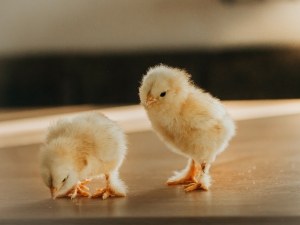
Watching chicks hatch can be a beautiful yet nerve-wracking experience. This isn’t always a smooth process, watching your baby chicks struggle to hatch can make anyone uncomfortable. This struggle can happen if your chick’s membrane is dry.
If the egg has a dry membrane, and you’re wondering why, then this article is for you
Table of Contents
Chick hatching with a dry membrane:
A chick hatching with a dry membrane is not an uncommon occurrence, but it is a dangerous one. This is why this happens and what to do:
Why this happens:
A chicken egg shell is porous, it lets gases like oxygen into the egg and lets gasses like carbon dioxide, which is a waste gas, out of the shell.
The shell also allows moisture to enter the shell, a good amount of moisture will keep the membrane in the shell from becoming too dry.
The correct humidity level to set your incubator at is between 50 and 55%, this allows moisture to be maintained in the egg but not too much to where the bird may risk drowning in the egg.
If the humidity levels of the incubator are set to a level that is too low, then this can cause the egg to have a dry membrane.
If there is too little humidity in the incubator then this will cause the membrane to attach to the chick’s body and dry on it, this is called shrink wrapping.
The membrane will wrap so tightly on the bird that the bird may not be able to turn or hatch out of its shell on its own.
This can be dangerous as the bird can die in the egg if it can’t hatch because it can’t move. The membrane, when dried onto the chick, may be too strong for the bird to break through.
What to do:
You can help the bird hatch if you realize that it is shrink-wrapped.
You don’t have to help the bird hatch completely, simply add some water to the area where the bird pipped and remove some of the shell making it easier for the bird to hatch.
Start off by applying a damp warm cloth, or paper towel dampened with some warm water, to the edges of the visible membrane where the bird has pipped.
Once the membrane has moistened, slowly and carefully peel some of the shell off, do this very gently.
If there is resistance when you pull the shell off, as though the bird is attached to the shell, then leave this area alone and try to peel elsewhere.
You don’t have to peel the whole shell off, moistening the membrane, and peeling some of the shell off, will make it easier for the bird to hatch. The chick can hatch on its own from here.
It only takes a tiny bit of water to get the membrane back to being slime so don’t overdo it when you add water to the membrane.
After the bird hatches:
If there is some shell, or membrane, still attached to the bird after the bird hatches, then you can soak the bird to remove the rest of the shell and membrane.
Grab a mug and pour some warm water into it. Place the chick in the mug but leave its head out of the water.
Use your nails to gently scrape the membrane and shell off of the bird and use a damp cloth to rub the remaining membrane off of the bird’s head
The bird that needed help may be weak. If this is the case, leave this bird in its own incubator where other birds won’t be able to peck at it and where it can gain some strength in its own time.
How to prevent this from happening:
Shrink wrapping happens because the humidity levels in the incubator are too low.
You can keep this from happening in future by making sure that there are no humidity fluctuations in the incubator while the eggs are in there and by keeping the humidity levels high enough.
Using a hydrometer in the incubator is another way to truly measure the humidity levels in the incubator.
Testing whether your incubator can run at optimum humidity for 21 days, before you place the eggs in there, is also recommended.
If you enjoyed this article then you may also be interested in other chicken related articles. Here are some articles that you may be interested in: Newly Hatched Chick Bleeding, Shrink Wrapped Chick, Baby Chick Swollen Abdomen, Baby Chick Not Growing Feathers, Sticky Chick,

